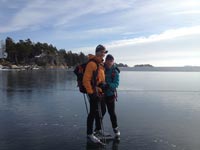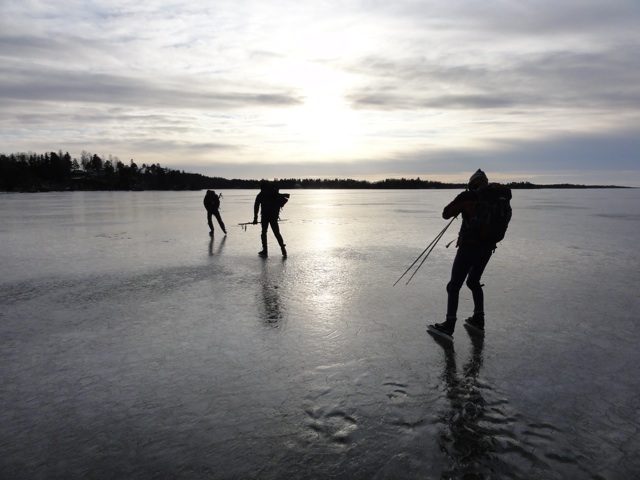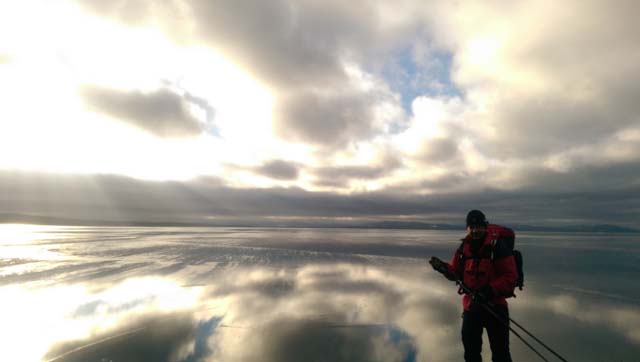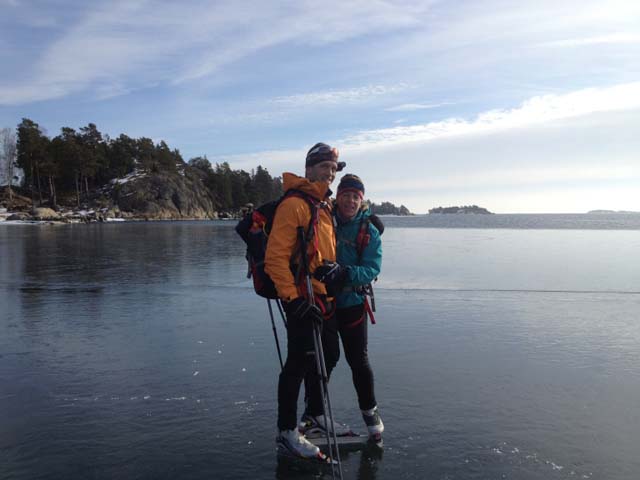
Sofia from the Nature Travels team, who is from the Stockholm Archipelago in Sweden, gives some tips on staying safe on lake and sea ice:
Here in England we still have warm temperatures during the days, but at night the colder temperatures are rolling in. It’s now time to start planning your winter adventure! One of our most unique winter experiences is Ice Skating on Natural Ice, which takes place on frozen inland lakes and/or in frozen areas of the Baltic Sea in the Stockholm Archipelago.
When you grow up in Sweden, part of your general education is ice knowledge, knowing how to keep safe on and around the ice. All Nature Travels experiences on natural ice are guided by experienced guides, but it never hurts to freshen up on some ice knowledge.
Ice knowledge:
NB: The following information is presented for general guidance and information only – it is not a substitute for professional guiding or instruction and Nature Travels accepts no responsibility for its accuracy or completeness.

This “knowledge” should be studied and discussed with those knowledgeable and experienced in activities on ice before going out on the ice. It is important to have a good knowledge of rescue techniques before going out on to the ice.
- Never be alone on the ice.
- Never leave children alone around or on the ice.
- Always tell somebody where you’ll be and when you plan to return.
Recommended minimum ice thickness:
(Based on guidelines from Lanark Highlands Fire Service)
- 7cm or less: STAY OFF!
- 10cm: Suitble for ice fishing, walking or cross country skiing
- 12cm: Suitable for one snowmobile or ATV
- 20-30cm: Suitable for one car or small pickup
- 30-38cm: Suitable for one medium pickup
Never walk on ice unless you are sure that it will hold your weight. Blue ice must be at least 10 cm thick. Always test the ice with the ice pick if you are unsure.
It is important to know that there are different types of ice with different levels of support. The ice does not look the same everywhere.
Remember that new ice, spring ice, snow-covered ice and sea ice may be weak.
Know the ice weak points!
- cracks in the ice
- reeds
- jetty
- bridge
- peninsular
- drain
- outlet
- inlet
- small passages of water
- where there are stones, etc, under the water

Safety equipment when on the ice:
Always carry ice claws and other safety equipment on the ice.
You need, among other things, to take with you:
- Small ice claws for rescue
- Large ice pick to test the ice
- Rescue rope
- Something to help with buoyancy
- Spare change of clothes in waterproof bag
When you go out on the ice, you should always have at least one adult companion (equipped with rescue rope) with you. It is not certain that you can manage to get out of a hole with only small ice claws. The higher the speed at which you are travelling, the further out you will be on thin ice before it cracks and the more difficult the rescue.
How to rescue someone who has fallen through the ice
If someone falls into the water, tell the person to swim to the edge of the ice and use their elbows to lift themselves partially out of the water. Have them go to the edge of the ice where they came from, since it held their weight up until that point, whereas the ice around the other edges might be weak. The weight of their wet clothes will probably make it impossible for them to lift themselves up out of the water––the main objective is for them to just get a grip on the edge of the ice, so don’t let them waste energy trying to pull themselves out.

They should use the ice claws to get a grip on the ice. Instruct the victim to kick their legs and to try to make themselves as horizontal as possible. They should kick their legs as they would if they were swimming and come out of the hole in a horizontal position, with their belly on the ice. Once the victim is out of the water, they should roll away from the hole to minimise the impact of their weight on the ice.
Be aware that would-be rescuers frequently become victims when they fall through the ice as well.
- Always have something between you and the victim – “the extended arm”. You should throw a long object that the victim can hold on to, such as a pole, a rope, a tree limp, or even a long scarf. Connecting yourself with the drowning person with a long object will keep you out of harm’s way. Pull the victim out. Stay low, stay off the thin ice, and pull hard. If you have helpers, have them use their strength to assist with pulling and make sure they stay away from the thin ice.
- Warm the victim. If the victim is breathing and conscious, bring them inside or somewhere warm. They may need to be treated for shock as soon as possible.
- Get the victim medical attention as soon as possible. Even if they feel fine, they should still be examined by a medical professional.
Ice should be treated with respect, but don’t let this scare you! Skating on natural ice is a great adventure and a magical experience! Stay safe out there!
Best regards
Sofia from the Nature Travels team
